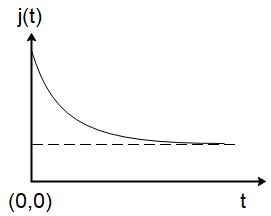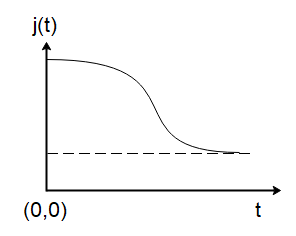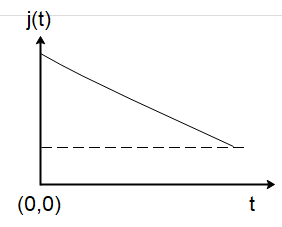
An infinite line charge of uniform electric charge density $ \lambda $ lies along the axis electrically conducting an infinite cylindrical shell of the radius $ R $ . At time $ t = 0 $ , the space in the cylinder is filled with a material of permittivity ε and electrical conductivity $ \sigma $ . The electrical conduction in the material follows Ohm's law. Which one of the following best describes the subsequent variation of the magnitude of current density $ j\left( t \right) $ at any point in the material?
(A)

(B)

(C)

(D)





Answer
554.1k+ views
Hint : In this solution, we will determine the electric field due to a line charge at a distance equal to the radius of the cylinder. The current density generated in the cylinder will be determined using ohm’s law. The current in the
Formula used: In this solution, we will use the following formula:
-Electric field due to a line charge: $ E = \dfrac{{2k\lambda }}{r} $ where $ \lambda $ is the line charge density of the line charge and $ r $ Is the distance of the point from the charge.
- Ohm’s law: $ J = \sigma E $ where $ J $ is the current density and $ \sigma $ is the electrical conductivity and $ E $ is the electric field.
Complete step by step answer
Let us start by calculating the current density in the cylinder. Since the electric field due to a line charge inside the cylinder will be
$ E = \dfrac{{2k\lambda }}{r} $ ,
We can determine the charge density as
$ J = \sigma \left( {\dfrac{{2k\lambda }}{r}} \right) $
Now we know that the current density is the ratio of the current in the circuit $ I $ to the area of the cylinder $ A $ . So we can write
$ J = \dfrac{I}{A} $
$ \Rightarrow I = JA $
Substituting the value of current density this in the above equation, we get
$ I = \sigma A\left( {\dfrac{{2k\lambda }}{r}} \right) $
Since $ I = \dfrac{{dq}}{{dt}} $ , we can write
$ \dfrac{{dq}}{{dt}} = \sigma A\left( {\dfrac{{2k\lambda }}{r}} \right) $
The charge in the line charge can be calculated as the product of line charge density and the length as
$ q = \lambda l $
So, we can write
$ \dfrac{{d(\lambda l)}}{{dt}} = \sigma 2\pi rl\left( {\dfrac{{2k\lambda }}{{2\pi {\varepsilon _0}r}}} \right) $ $ \left( {\because A = 2\pi rl\,{\text{and}}\,{\text{k = }}\dfrac{1}{{4\pi {\varepsilon _0}}}} \right) $
Now the length of the line remains constant so the variable in the above equation must be the line charge density which varies with time.
Integrating the above equation with time, we get
$ \lambda = {\lambda _0}{e^{ - \sigma t/\varepsilon }} $ where $ {\lambda _0} $ is the term containing all the constants.
Multiplying both sides by $ \dfrac{{\sigma 2k}}{r} $ , we get
$ J = {J_0}{e^{ - \sigma t/\varepsilon }} $
Hence the graph of current density with time is exponentially decaying with time which corresponds to option (A).
Note
In this solution, it is difficult to confer that the line charge density will vary with time which is why we solve the equations to see that the current density could be varying with time only the line charge density is changing. We must also be aware of the general behaviour of different functions when plotted with respect to time.
Formula used: In this solution, we will use the following formula:
-Electric field due to a line charge: $ E = \dfrac{{2k\lambda }}{r} $ where $ \lambda $ is the line charge density of the line charge and $ r $ Is the distance of the point from the charge.
- Ohm’s law: $ J = \sigma E $ where $ J $ is the current density and $ \sigma $ is the electrical conductivity and $ E $ is the electric field.
Complete step by step answer
Let us start by calculating the current density in the cylinder. Since the electric field due to a line charge inside the cylinder will be
$ E = \dfrac{{2k\lambda }}{r} $ ,
We can determine the charge density as
$ J = \sigma \left( {\dfrac{{2k\lambda }}{r}} \right) $
Now we know that the current density is the ratio of the current in the circuit $ I $ to the area of the cylinder $ A $ . So we can write
$ J = \dfrac{I}{A} $
$ \Rightarrow I = JA $
Substituting the value of current density this in the above equation, we get
$ I = \sigma A\left( {\dfrac{{2k\lambda }}{r}} \right) $
Since $ I = \dfrac{{dq}}{{dt}} $ , we can write
$ \dfrac{{dq}}{{dt}} = \sigma A\left( {\dfrac{{2k\lambda }}{r}} \right) $
The charge in the line charge can be calculated as the product of line charge density and the length as
$ q = \lambda l $
So, we can write
$ \dfrac{{d(\lambda l)}}{{dt}} = \sigma 2\pi rl\left( {\dfrac{{2k\lambda }}{{2\pi {\varepsilon _0}r}}} \right) $ $ \left( {\because A = 2\pi rl\,{\text{and}}\,{\text{k = }}\dfrac{1}{{4\pi {\varepsilon _0}}}} \right) $
Now the length of the line remains constant so the variable in the above equation must be the line charge density which varies with time.
Integrating the above equation with time, we get
$ \lambda = {\lambda _0}{e^{ - \sigma t/\varepsilon }} $ where $ {\lambda _0} $ is the term containing all the constants.
Multiplying both sides by $ \dfrac{{\sigma 2k}}{r} $ , we get
$ J = {J_0}{e^{ - \sigma t/\varepsilon }} $
Hence the graph of current density with time is exponentially decaying with time which corresponds to option (A).
Note
In this solution, it is difficult to confer that the line charge density will vary with time which is why we solve the equations to see that the current density could be varying with time only the line charge density is changing. We must also be aware of the general behaviour of different functions when plotted with respect to time.
Recently Updated Pages
Master Class 12 Business Studies: Engaging Questions & Answers for Success

Master Class 12 Economics: Engaging Questions & Answers for Success

Master Class 12 English: Engaging Questions & Answers for Success

Master Class 12 Maths: Engaging Questions & Answers for Success

Master Class 12 Social Science: Engaging Questions & Answers for Success

Master Class 12 Chemistry: Engaging Questions & Answers for Success

Trending doubts
What are the major means of transport Explain each class 12 social science CBSE

Which are the Top 10 Largest Countries of the World?

Draw a labelled sketch of the human eye class 12 physics CBSE

Explain sex determination in humans with line diag class 12 biology CBSE

The pH of the pancreatic juice is A 64 B 86 C 120 D class 12 biology CBSE

Explain sex determination in humans with the help of class 12 biology CBSE




